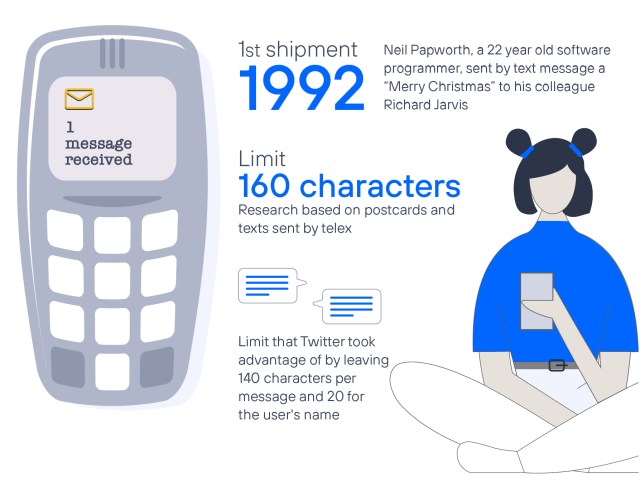What is an SMS?
A question with a more or less simple answer depending on which generation the reader belongs to?
The popularity that SMS reached in the 90s and 2000s has been eclipsed by the development of other services that have immediacy in communications as their flagship.
But what exactly is SMS?
Such was its degree of popularity that even the RAE includes in its dictionary these acronyms in English that define it as ‘a telephony service that allows sending and receiving messages that are written on the screen of a mobile phone’.
The abbreviation stands for Short Message Service and allows short messages to be sent (with a limitation of characters for a reason that we will explain later) between mobile phones.
Sending the first SMS
The first SMS in history was sent on 3 December 1992, when a 22-year-old software programmer named Neil Papworth sent his holiday greetings to his colleague Richard Jarvis with a brief ‘Merry Christmas’, two words that, unbeknownst to him, would go down in the history not only of mobile telephony and technology, but also of society as a whole.
As Papworth himself acknowledged, ‘in 1992, I had no idea how popular text messaging would become, and that it would give rise to emojis and messaging services used by millions of people around the world. Looking back, I realise the importance of that first Christmas message in mobile history.
Short messages that, from their birth in the early 1990s to their peak of popularity a few years later, greatly changed the way people communicated, even introducing new acronyms or expressions into everyday life due to the limited space available to them.
As an example of this is, for example, the popularisation of emoticons, which should not be confused with emojis despite being relatively similar.
But why were these messages limited in space? Let’s look at the answer.

Why were SMS messages limited to 160 characters?
In our Centenary book we can answer this question.
Who was to blame? A German engineer named Friedhelm Hillebrand, who in the 1980s was chairman of GSM, the group that was standardising and specifying the 2G network.
Although it is true that it should be pointed out that, in addition, SMS had originally been conceived by GSM as a way of communicating between the network provider and the customer, without the option of communications taking place precisely between users.
Going back to Hillebrand and the character limitation, he was given the task of defining how many characters were sufficient.
After writing numerous test messages completely at random and counting the words, he found that it did not exceed 160 characters. However, the technical committee in charge of the matter did not accept the conclusions of an excessively ‘home-made’ method.
He then went on to conduct more serious market research using thousands of postcards and telex texts, concluding that they did not exceed 150 characters, which is why he again recommended the 160-character limit, successfully this time.
A character limitation that years later, for example, would influence the social network Twitter (now called X), which for a long time had as its flagship the initial limitation of 140 characters precisely to adjust to the 160 of SMS, leaving a margin of 20 additional characters to add the user’s name or other commands that one wished to enter.
Telefonemas, SMS or Whatsapp from… a century ago!
Although SMS are recent, at the beginning of its century-long history Telefónica offered a service that can be considered – obviously saving the distances – a precursor of these short messages or messaging services such as Whatsapp.
These were the telefonemas, which existed until 1934, as we explain on our Centenary website.
As you well know, Telefónica was born ten years earlier, in 1924. During that decade, one of the sources of income for the company (then known as CTNE) was the sending of these telefonemas, ‘short written messages that could be sent from telephone to telephone to give a message so brief and specific that it did not require a call’.
If from a recent perspective it seems to us that SMS were a revolution in how we communicate, imagine how these telephonemes would have looked no less than a hundred years ago.
The company earned more than 60 million pesetas for this service during the period in which they were active. The reason why they ceased to be offered was an agreement between Telefónica and the State so that this service would not compete with telegrams.
So, could we say that we were the grandparents of SMS and instant messaging?







